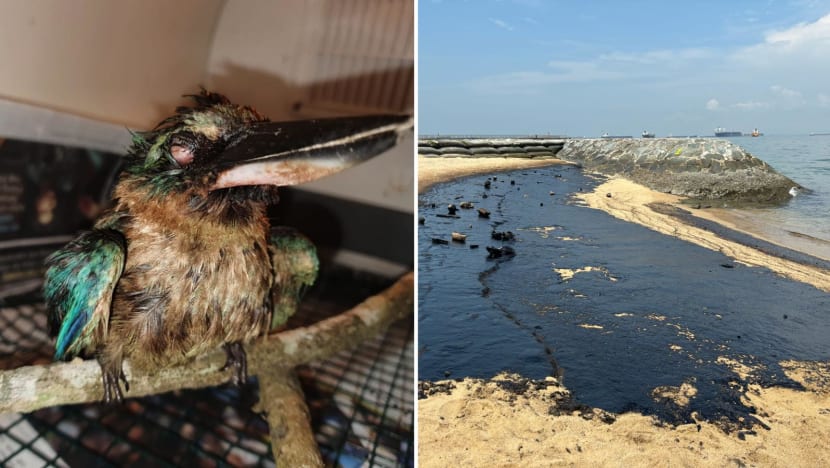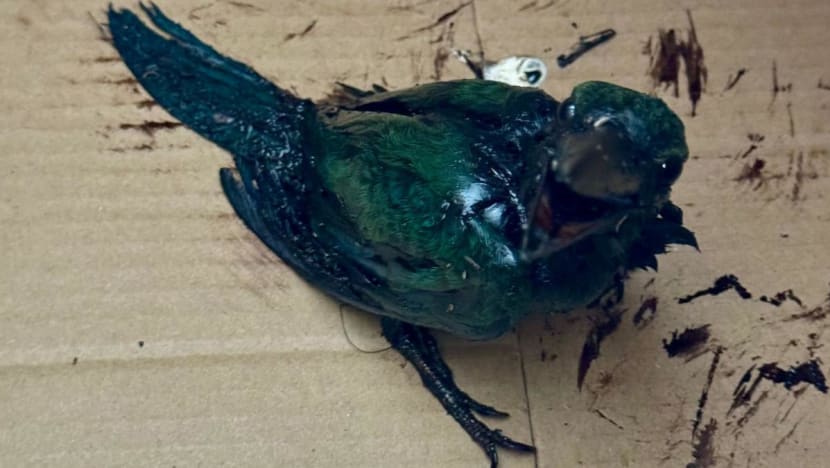Oil spill: After 2 kingfishers die, race against time to clean beaches for nesting turtles
A pair of kingfishers rescued from the oil spill around Singapore's shores are still fighting for their lives.

One of two oil-slicked kingfishers that have died so far (left) and oil trapped on the beach at East Coast Park on Jun 16, 2024, two days after an oil spill at Pasir Panjang Terminal. (Photos: ACRES, CNA/Davina Tham)

This audio is generated by an AI tool.
SINGAPORE: Clean-up crews mopping up the oil spill around Singapore's shores are racing against time to limit the impact on wildlife after rescue efforts failed for two oil-drenched kingfishers.
This is because the beach at East Coast Park is a nesting site for critically endangered hawksbill turtles and vulnerable coastal horseshoe crabs, said Mr Lester Tan, chair of Nature Society (Singapore)'s Marine Conservation Group.
A stretch of the beach at East Coast Park, from areas B to H, has been closed until further notice as crews work to recover the oil still trapped at the shoreline.
"If they can finish cleaning up that part before the nesting turtles come up on shore on the next spring tide, which is just a couple of days later, I think we're on the safe side," Mr Tan told CNA on Wednesday (Jun 19).
Otherwise, nesting turtles and crabs may have to pass through the oil slick to reach the beach, he said.
Spring tides are tides with the highest high tides and lowest low tides. They occur when there is a full moon or during a new moon, according to the National Environment Agency.
This month's full moon, known as a Strawberry Moon, is expected to rise around Jun 22 in Singapore.

Mr Stephen Beng, chair of the Friends of Marine Park community, said exposure to oil can impair the fitness and reproductive ability of sea turtles.
"As air breathers, sea turtles can ingest oil which blocks airways, fills stomachs, damages tissues and organs," he said.
"Oiled beaches can kill the eggs or cause developmental defects for hatchlings – it's also another obstacle for them in the gauntlet they must already go through at birth."
Oil contamination of wildlife habitats is critical during the nesting season for sea turtles on the eastern coast and Southern Islands, agreed Mr Oliver Chang, lecturer in veterinary technology at Temasek Polytechnic's School of Applied Science.
Aside from East Coast Park, beaches at St John's, Lazarus and Kusu islands have been closed since Jun 16 after oil slicks were seen at the first two islands.
Over at the Sisters' Islands, if there is any oil slick when the spring tide comes, then the oil may come into contact with corals there, said the Nature Society's Mr Tan.
Sisters' Islands Marine Park protects coral reefs and a coral nursery. As of the evening of Jun 17, there were no signs of oil slick in the park, with oil sheen seen in the surrounding waters.
Daily Cuts:

The oil spill happened after a dredger hit a stationary bunker vessel at Pasir Panjang Terminal on Jun 14, damaging an oil cargo tank on the bunker vessel, which released about 400 metric tonnes of fuel into the sea.
Oil slicks have also been spotted at the beaches of Sentosa island, Labrador Nature Reserve and Marina South Pier. Some oil was also seen off the coast of Changi.
Close to 1,500m of containment booms have been deployed to contain further spread of the oil, with another 1,600m to be deployed over the coming days.
Mr Tan noted that dispersants were also sprayed on the oil spill after the two vessels hit. Dispersants contain some toxins but little is known about how they could affect wildlife and feeding grounds, he said.
Temasek Polytechnic's Mr Chang said that oil will disperse over time but its lingering presence can continue to impact marine ecosystem.
"Dispersed oil particles may settle on the seabed, potentially smothering sensitive habitats like coral reefs or seagrass beds. Certain oil compounds can persist for years, posing ongoing risks to wildlife through bioaccumulation in the food chain," he said.
TWO KINGFISHERS IN TREATMENT
At least four kingfishers have been retrieved so far from the oil spill in Singapore's waters.
The National Parks Board (NParks) and wildlife group Animal Concerns Research and Education Society (ACRES) were each treating two collared kingfishers.
Two of the birds – one with NParks and the other with ACRES – have died.
NParks group director Dr Anna Wong said its two kingfishers were treated at the Centre for Wildlife Rehabilitation.
The birds were given fluids and pain relief, and their mouth, eyes and nasal areas were cleaned of oil. After reaching a stable state, they were hand fed and slowly washed with detergent and warm water.
"The survival rate for these birds is low even with prompt veterinary intervention due to stress and accidental ingestion of the oil which is toxic to them," she said.


ACRES co-CEO Kalai Vanan Balakrishnan said the group's first kingfisher was found on Jun 15 at Keppel on the mainland, and the second on Jun 17 at Lazarus Island.
They were retrieved by members of the public and then passed to ACRES.
The first kingfisher died within 36 hours of being found. A post-mortem found liver issues that could have been caused by toxins from oil ingestion, and signs of dehydration, said Mr Kalai.
He pegged the second kingfisher's chances of survival at about 30 per cent. The bird has been cleaned five times as of Wednesday afternoon to remove oil from its feathers and inside its mouth.
As this process causes birds stress that may become fatal, the cleaning is limited to about 15 minutes each time, said Mr Kalai.
But there is still a lot of oil on the kingfisher from Lazarus, and he expects the bird will need to be cleaned another four times.


MONTHS TO RETURN TO THE WILD
Mr Kalai also cautioned members of the public against attempting to clean oil-covered birds by themselves.
Cleaning is a difficult process as bird feathers are porous and oil can become embedded in feather follicles, he said.
The birds will be stressed and unable to regulate their body temperature as they are covered in oil. They are also likely to be dehydrated as they may have been stranded for several hours.
"If you just take the bird and just start washing off the oil, the bird is almost guaranteed to die," he said.
Even after the oil has been cleaned from the bird, it could be months before they are released back into the wild.
The feathers of aquatic birds like kingfishers have a natural oil coating that makes them waterproof. This allows them to fly even after diving into water, explained Mr Kalai.
But this waterproof coating gets washed off in the process of removing the fuel oil, and could take months to be restored.
Mr Kalai said birds rescued from glue traps represent "a similar type of nightmare", and that a previous rescue took up to 10 months to be released.
During those months, rescue and rehabilitation officers must not just care for the bird but also make sure it does not imprint onto humans, so that it can return to the wild, he added.
Nature Society's Mr Tan also spotted two oil-stained birds – a Pacific reef heron and a purple heron – around Marina East Drive in East Coast Park on the morning of Jun 16.


The birds could still fly, so it was difficult to get close to them and track them or help them, he said.
Asked whether there could be more wildlife affected by the oil spill than has been sighted or reported so far, Mr Tan said this could be the case.
But he did not expect more oil-slicked wildlife to be found. "Unfortunately, I think whichever (animals) were stained in the oil spill or probably drenched in the oil spill would have perished by now."
Temasek Polytechnic's Mr Chang said continuous monitoring was needed, with methods like regular aerial surveys of tagged seabird populations to assess their distribution and biological sampling of fish tissues and bird feathers to measure contamination levels.
Dr Wong said NParks will continue to closely track the immediate impact of the oil spill on Singapore's marine habitats, including corals and wildlife.
"Biodiversity surveys conducted by the scientists as well as volunteers from Friends of Marine Park at St John's Island and Lazarus Island on Jun 16 had indicated no significant impact on the marine biodiversity there," she said.
NParks will assess if habitat restoration efforts are needed, and also explore activating volunteers for post clean-up intertidal surveys, Dr Wong added.
She also advised those who encounter any oil-slicked animal to contact the Animal Response Centre at 1800 476 1600.














